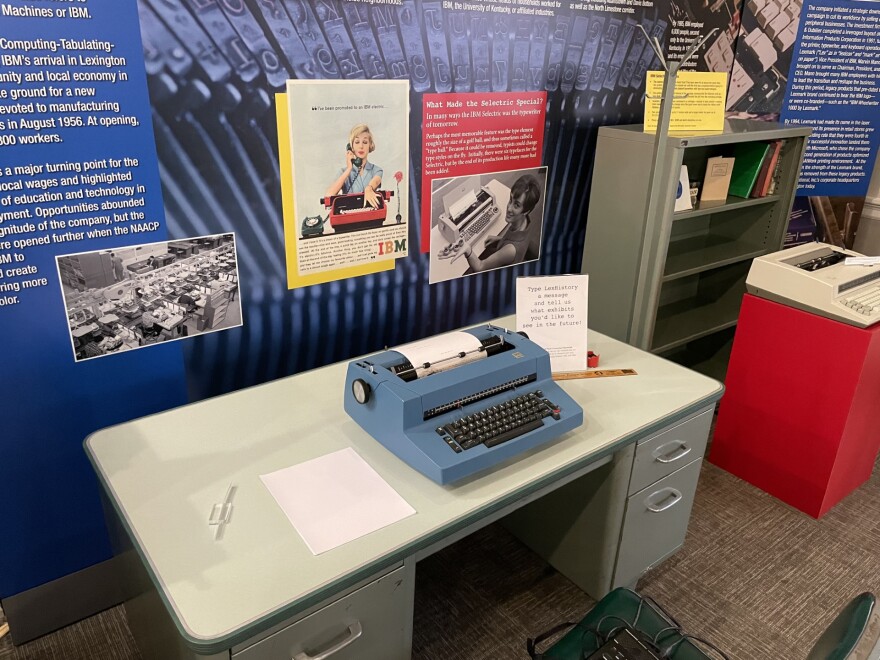The Lexington History Museum has a relatively short history in its current location. It opened less than two weeks ago in the Dr. Thomas Hunt Morgan House on North Broadway. But, in addition to all the facts included inside the exhibits, there is a story about perseverance.
A trip inside the Lexington History Museum will provide an opportunity to learn a bit about the second-largest city in Kentucky from 3000 BCE to about the year 2000.

“So, you’ll start before Europeans come to McConnell Springs all the way through IBM in Lexington,” said Higgins.
That’s Museum Director Mandy Higgins. McConnell Springs, situated off Old Frankfort Pike is known as Lexington’s birthplace.
The origin of the Lexington History Museum dates back to 1998 and it was first established in the Historic Courthouse downtown in 2002. About a decade later, it, along with other inhabitants of the old courthouse moved out when lead paint dust was found.
Higgins said that led to the Museum and its contents going into storage for a little over a decade.
“The board worked very hard to make sure the Museum, parts of the Museum were still out there, partnerships with the Library, pocket museums in downtown businesses, doing a lecture series, doing, publishing some books, but there wasn’t a physical place for the collection,” said Higgins.

One of those originally on the Lexington History Museum Board was Foster Ockerman Junior, whose picture hangs inside the Museum. It was Ockerman who was the face of the history museum effort, appearing before the City Council and any other group he could to stress the importance of keeping the project moving forward. He died last December.
Higgins calls it serendipity when the Bluegrass Trust for Historic Preservation, which stewards the Thomas Hunt Morgan House, and the Museum joined together in the historic building.
Katrina Dixon is curator and exhibit manager at the Lexington History Museum. Since coming to the position in January, Dixon said there’s been a lot of culling inventories to see what objects would be a fit.
“It’s been a lot of trying to make sense of paperwork that like I’ll have deeds of gifts for things that I have not seen yet or objects where I can’t find the paperwork to tell me how we got them. So, it’s been a lot of detective work,” said Dixon.

Most people would consider it nearly impossible to talk about Lexington and the central Kentucky area without more than a mention of the horse business. Dixon said the horse reference begins with the first recorded history of the town.
“You could bet at Post Waites Tavern before…that was the original site of the Phoenix Hotel, which has always been an Inn or place for others and whether it was good or bad you had a place at the Phoenix Hotel kind of thing. So, you could place your bets,” said Dixon.
According to Museum Director Mandy Higgins other topics covered include agriculture and wealth, laborers and slave laborers, bourbon, the LGBTQ community, and a large section on what was IBM.

“IBM really revolutionized and changed Lexington. It comes at the same time that their urban services boundary is introduced. It helps push for some of the merger conversation and it explodes the population here in Lexington and so we really couldn’t tell the 20th century history of Lexington without talking about IBM and eventually Lexmark,” said Higgins.
A replica of the “type ball” hangs over the IBM-Lexmark exhibit. The first Selectric was introduced by IBM in the early 1960s. Higgins said millions were sold and produced right in Lexington.
Martina Barksdale is director of communications with VisitLex, the city’s convention and visitors’ bureau. Visitors to the Museum may come away with an interest in a deeper dive at various sites.
“Any time that you’re really able to tell the story of something, I think that creates a draw for people to want to learn more and want to visit. So, we want to uplift them just like they’re uplifting all of the industries that they’re telling the history on,” said Barksdale

Barksdale noted the History Museum is great for tourism. She added it’s also a way of highlighting both native Lexingtonians and transplants’ contributions in building the community.
“It’s so educational whether you’re a traveler or a local..and like museums are fun..I know growing up some people are like, no but, museums are increasingly popular and I think it’s because people are interested,” said Barksdale.
Currently, the newly located Lexington History Museum at 210 North Broadway is open three days a week…noon to 4:00 on Thursday and Friday and 10:00 to 4:00 on Saturdays.
* WEKU is working hard to be a leading source for public service, fact-based journalism. Monthly sustaining donors are the top source of funding for this growing nonprofit news organization. Please join others in your community who support WEKU by making your donation




